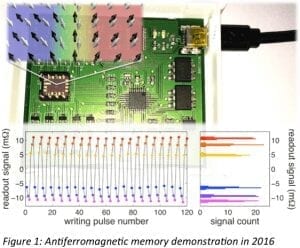
Hiroshima University, the National Institute of Information and Communications Technology, and Panasonic Corporation announced the development of a terahertz (THz) transmitter capable of signal transmission at a per-channel data rate of over ten gigabits per second over multiple channels at around 300 GHz. The aggregate multi-channel data rate exceeds one hundred gigabits per second. The transmitter was implemented as a silicon CMOS integrated circuit, which would have a great advantage for commercialization and consumer use.
This technology could open a new frontier in wireless communication with data rates ten times higher than current technology allows.
Details of the technology were presented at the “International Solid-State Circuit Conference (ISSCC) 2016,” held from January 31 to February 4 in San Francisco, California.
The THz band is a new and vast frequency resource not currently exploited for wireless communications. Its frequencies are even higher than those used by the millimeter-wave wireless local area network (from 57 GHz to 66 GHz), and the available bandwidths are much wider.
Since the speed of a wireless link is proportional to the bandwidth in use, THz is ideally suited to ultrahigh-speed communications.
The research group has developed a transmitter that covers the frequency range from 275 GHz to 305 GHz. This frequency range is currently unallocated, and its future frequency allocation is to be discussed at the World Radiocommunication Conference (WRC) 2019 under the International Telecommunication Union Radiocommunication Sector (ITU-R).
Today, most wireless communication technologies use lower frequencies (5 GHz or below) with high-order digital modulation schemes, such as the quadrature amplitude modulation (QAM), to enhance data rates within limited bandwidths available. The research group has successfully demonstrated that QAM is feasible at 300 GHz with CMOS and that THz wireless technology could offer a serious boost in wireless communication speed.
“Now THz wireless technology is armed with very wide bandwidths and QAM-capability. The use of QAM was a key to achieving 100 gigabits per second at 300 GHz,” said Prof. Minoru Fujishima, Graduate School of Advanced Sciences of Matter, Hiroshima University.
“Today, we usually talk about wireless data-rates in megabits per second or gigabits per second. But I foresee we’ll soon be talking about terabits per second. That’s what THz wireless technology offers. Such extreme speeds are currently confined in optical fibers. I want to bring fiber-optic speeds out into the air, and we have taken an important step toward that goal,” he added.
The research group plans to further develop 300-GHz ultrahigh-speed wireless circuits.
“We plan to develop receiver circuits for the 300-GHz band as well as modulation and demodulation circuits that are suitable for ultrahigh-speed communications,” said Prof. Fujishima.
Learn more: Terahertz wireless technology could bring fiber-optic speeds out of a fiber
The Latest on: Terahertz wireless technology
[google_news title=”” keyword=”terahertz wireless technology” num_posts=”10″ blurb_length=”0″ show_thumb=”left”]
via Google News
The Latest on: Terahertz wireless technology
- Japan Releases 6G Device, 500% Faster Than 5Gon May 6, 2024 at 4:16 am
One of the earliest high-speed 6G wireless devices in the world was introduced by a consortium of Japanese corporations, including DOCOMO, NTT, NEC, and Fujitsu. Up to 330 feet (100 meters) may be ...
- 6G era starts as new device hits data speeds 20x faster than 5Gon May 5, 2024 at 12:25 am
A consortium of Japanese telecommunications companies has developed a high-speed 6G wireless device capable of transmitting data at speeds up to 20 times faster than 5G, which means you can download ...
- Japanese companies develop 6G device capable of 100Gbps speedson May 3, 2024 at 9:35 pm
It was only in 2022 that 5G could arguably be considered to have gone mainstream. Two years later, scientists have already announced amazing results from a next-gen wireless technology—reaching speeds ...
- Japan develops world’s first 6G device that’s 20 times faster than 5Gon May 2, 2024 at 7:45 am
A group of Japanese telecommunication firms have developed a high-speed 6G wireless gadget that can carry data at up to 20 times the speed of 5G. The device can transmit data at 100 gigabits per ...
- Global Medical Terahertz Technology Industryon April 26, 2024 at 5:03 am
Global Medical Terahertz Technology Industry is valued at US$ 135.29 Mn in 2022 and is projected to grow at a CAGR of 17.1% By 2032 ...
- First curved data link side-steps key 6G wireless challengeon April 17, 2024 at 5:00 pm
Next-generation wireless signals will no longer ... frequency gigahertz radiation to carry data, but future technology will rely on sub-terahertz waves, which have as much as 100 times the data ...
- New type of tunable filter reveals the potential for terahertz wireless communicationson March 11, 2024 at 9:05 am
"In addition to our method's application in communications systems, we also envisage uses in scanning and imaging technologies in medicine and industry," Kanamori says. One advantage of terahertz ...
- Research Applicationson August 4, 2023 at 12:25 pm
The BTTC, in collaboration with Dr. Karim Alavi in the Division of Colorectal Surgery at UMass Medical School in Worcester, is evaluating the tissues’ intrinsic contrast, combining it with the ...
- Biomedical Terahertz Technology Centeron August 4, 2023 at 12:23 pm
The Biomedical Terahertz Technology Center (BTTC) was established in 2012 with the goal of translating the extensive terahertz technology expertise available at UMass Lowell to biomedical applications ...
- Terahertz technologies explainedon February 7, 2023 at 8:49 am
Communications: Terahertz technology is being researched for use in wireless communications. THz radiation has shorter wavelengths than microwaves and therefore has higher bandwidth capacity for data ...
via Bing News











